Power and Periphery: A Study of Contemporary Japan - Winter Term 2010
February 17, 2010
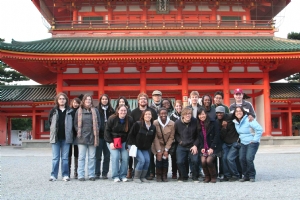 During Winter Term in January, 20 DePauw students traveled to Japan to study how thousands of years of history have shaped many facets of Japanese life today. The trip, Power and Periphery: A Study of Contemporary Japan, was designed by Hiroko M. Chiba, associate professor of modern languages (Japanese) and director of the Asian Studies Program, and Christopher S. Bondy, assistant professor of sociology.
During Winter Term in January, 20 DePauw students traveled to Japan to study how thousands of years of history have shaped many facets of Japanese life today. The trip, Power and Periphery: A Study of Contemporary Japan, was designed by Hiroko M. Chiba, associate professor of modern languages (Japanese) and director of the Asian Studies Program, and Christopher S. Bondy, assistant professor of sociology.
Students had three very different experiences in two weeks – a rural home-stay; a tour of hyper-modern Tokyo; and several days in the traditional Japanese city of Kyoto, the only major city not destroyed during World War II. The itinerary also included day trips to Hiroshima and the Peace Museum and to Osaka to visit Liberty Osaka, a human rights museum.
The course description states, “By studying issues of power and periphery, it allows students to explore some of the same issues that we see in the United States, but in a different socio-historical context. The complexities of Japanese culture let students see the connection between past and present – power and periphery.”
Students were introduced to Japanese political power by touring Tokyo, the capital and one of the centers of political power, including a guided tour of the Diet (Japan’s Parliament). Students also learned about Japan’s cultural power by visiting Kyoto, Japan’s imperial capital for more than 1,000 years.
The group observed the periphery of Japanese society in two ways: during their home-stay in a rural area and by learning about Japan’s largest minority group, the burakumin, by visiting a buraku district in Osaka and the Liberty Osaka Museum.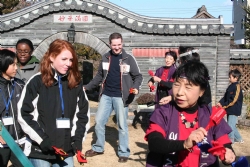
Students’ first introduction to Japan was through their home-stay families. “Students explored Japanese culture not just through tourism, but also through immersion in Japanese society,” Chiba says.
“The students said they wanted to stay longer with their Japanese families – even those who didn’t speak any Japanese. More than half of the students hadn’t taken a Japanese-related course at DePauw.
“The home-stay was in a remote farming area near Toyo University. The students visited the university, attended classes and met with Japanese students. I’m very proud of the DePauw students for their open-mindedness. They said that the home-stay was one of the best parts of the experience.”
Eilene R. Ladson ’12 misses her home-stay family. “The home-stay was my favorite part of the trip because I learned so much about Japan and felt so welcomed by my family. My host sister treated me like her own sister,” Ladson says.
“As a first-year student, I took Japanese for two semesters, and my first-year seminar was Modern Japan in Asia and the World. I have always had an interest in certain aspects of the Japanese culture such as the hierarchy system and the role of women,” Ladson says.
“Going to Japan was my first time abroad, and it was wonderful because I was finally able to see in action so many of the practices that I learned about. I was most impressed with the little acts of kindness that were embedded into everyday life.
Katelyn “Katie” A. Zolman ’13 took a semester of Japanese language last fall, and the trip was also her first time abroad. “I've wanted to go to Japan since middle school. I've always been interested in the language and the culture, and I decided this was a perfect opportunity.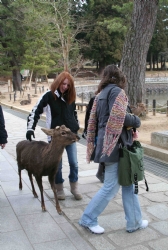 “I also wanted to see the places I'd read about and be exposed to another culture. I grew up in a small town, and I wanted to go somewhere very different,” Zolman says. “I really enjoyed the home-stay experience, as well. The trip wouldn't have been nearly as beneficial without it.”
“I also wanted to see the places I'd read about and be exposed to another culture. I grew up in a small town, and I wanted to go somewhere very different,” Zolman says. “I really enjoyed the home-stay experience, as well. The trip wouldn't have been nearly as beneficial without it.”
In addition to the home-stay, students were exposed to a variety of Japanese cultural experiences: traveling by bullet train; eating lunch in Ginza, an upscale shopping area; and attending a Sumo wrestling tournament.
The group took a day-trip to Nara, the first capital of Japan. “Nara is celebrating its 1,300th anniversary as establishment as a capital this year,” Bondy says. “The timing was fortuitous for our students to experience the celebration. Nara is known for its deer that are wild, but tame.”
Visiting Himeji Castle was another fortunate stop. “Himeji Castle will be under renovation for the next seven years,” Chiba says. “So, it was great timing for us.”
“It is one of the three original castles that wasn’t destroyed during World War II – said to be the most beautiful of the three,” Bondy says. “The person who built the castle was the one who really implemented the status hierarchy that marginalized the present- day burakumin.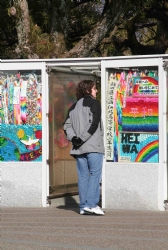
“Many of the students said they had not thought of Japan as having minority concerns or marginalized populations,” Bondy says. “Many talked about going to Liberty Osaka as an eye opening experience. You would expect the students to say how powerful Hiroshima is. It is. It’s very moving. But I was struck that they said Liberty Osaka as also a very powerful experience in terms of understanding just what discrimination means.”
“Hiroshima was my favorite place,” Zolman says. “It is such a beautiful city. I loved the feel, the attitude. It felt like the past was acknowledged but without dwelling on it and making a big deal out of it. They seemed to be very much about the present, and I really respected that.”
“It was a combination of things that gave me that feeling. Some was the Peace Museum itself, but mostly it was just the way the city had been rebuilt after the destruction from the war,” Zolman says. “The Peace Museum had really nice gardens, and it was beautiful – not overwhelmingly sad, like you might expect at a museum where so much destruction happened.” 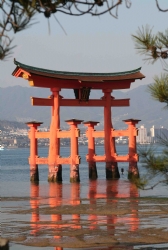
“The volunteers at the Peace Museum were really nice, too. There were some volunteers who knew English and explained stories to us. They just seemed eager to share their history.”
“After the museum, we went to an island just off the coast of Hiroshima,” Bondy says. “It’s really pleasant and quiet. There is a shrine that was built in the 9th Century. The students commented about how nice it was to have that experience after visiting the Peace Museum. They said, ‘It’s still beautiful here.’
“For the students, it was a nice way to balance that very powerful, emotional and visceral response to the Peace Museum. It was serene – a good way to finish that day.”
Professor Bondy recently received a grant from the National Endowment for the Humanities to support his project, "Beyond the Buraku: The Negotiation of Burakumin identity in Contemporary Japan." Click here to learn more.
Back